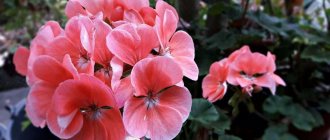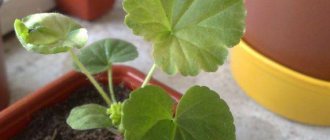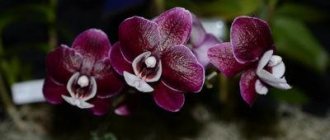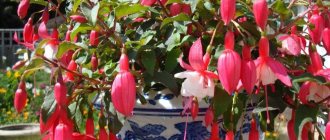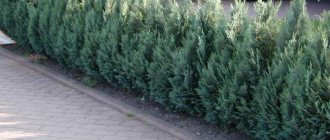Pelargonium from the geranium family is called indoor geranium by almost all gardeners. There is also outdoor geranium, which differs from pelargonium in the shape of leaves and flowers, resistance to frost, method of reproduction and growing area. You can learn about the difference between pelargonium and geranium on our website from the article “What is the difference between geranium and pelargonium“.
Indoor and outdoor geraniums are always dotted with flowers, growing alternately and emitting an aroma that cannot be confused with the smell of other flowers. Their leaves are also endowed with a special aroma. Because of this, both plants are used by the cosmetic industry to obtain essential oils. However, these plants should not be left unattended during development, growth and flowering, as they may be susceptible to disease and damage from pest infestations.
But geranium diseases (see photo) and their treatment are similar for both indoor and outdoor representatives. This will be discussed in detail in this article, as well as disease prevention measures.
Typical diseases of geranium
Diseases of geranium can be noticed by yellowed and drying leaves, the appearance of rust, spotting, swelling, lack of flowering, bacterial, fungal damage, root rot and viral infections. Let us consider the main diseases and methods of their treatment in more detail. If there are violations during care, geranium (pelargonium) appears:
Yellowness on leaves
We need to find out why geranium leaves lighten, turn yellow and wither, and then take resuscitation measures. This may be due to a lack of fresh air in the room, drafts, excessive watering or moisture deficiency, excess nitrogen in the soil or lack of micronutrients. The parameters of the pot also play an important role in the life of the plant. A narrow pot aggravates the development of the root system, so not only the leaves, but also other parts of the geranium die off. But if, with normal care, the leaves of a geranium turn pale, the reason can be determined by the development of the root system: if root rot has appeared or a mealybug is parasitizing, the leaves will turn yellow and dry out.
It is important to know! If the plant has just been replanted, and the leaves at the bottom of the bush begin to turn yellow, then this is considered a side effect. The yellow parts are removed, and the geranium continues its development.
No flowering
Geraniums are grown for their spectacular, large and beautiful flowers. It stops blooming in the presence of causative factors:
- insufficient lighting;
- low temperature;
- too large a container: roots grow intensively, flowering slows down or is absent;
- excess fertilizer;
- lack of nutrition in the soil;
- thickening of green mass, in the absence or insufficient pruning;
- root rot and scale insects.
To resuscitate a plant, you need to eliminate all negative factors and cure the root system.
Dried leaves
Why do geranium leaves have small leaves and dry edges: there is not enough moisture in the soil. When dry:
- flower - a fungal disease has appeared;
- leaves and the appearance of wet areas on the stems - stem rot has begun;
- lower leaves along the edges - there is not enough nutrition or old leaves are dying.
Fungi are eliminated by treating them twice with Fitosporin (a break of 7 days between treatments) and watering the plant with 5% Bordeaux mixture.
Botrytis mushroom
The fungal disease appears on the plant as gray spots, then brown and fluff; all parts of the bush wither when exposed to excessive moisture. How to treat geranium if the leaves are brown, rot and fall off:
- clear the soil of weeds and dry plant fragments;
- loosen the soil so that it absorbs water well, passes excess through drainage and dries out;
- remove and destroy parts of the bush affected by the fungus;
- treat geranium with fungicides.
Recommendation! The soil absorbs water well, allows it to pass through, and dries out during the morning spill no later than 11 o’clock.
Root rot
The activity of the fungus leads to yellowing of the leaf plates. Later, brown and even black spots appear on the leaves of indoor geranium. On the plant itself you can notice a light coating in the form of a cobweb due to advanced root rot and/or root worms. To get rid of rot, the following work is carried out:
- loosen the soil;
- exclude fertilizers with nitrogen;
- remove and destroy diseased stems with leaves;
- apply fungicides to waterlogged soils;
- for root bugs: cut off parts of the affected roots with a knife, and place healthy ones in hot water, dry them and sprinkle them with charcoal flour, then transplant the bush into new, sterile soil;
- for mealybugs: pelargonium is isolated and the parasites are removed by hand and sprayed with a soap-alcohol mixture. In advanced stages, they are treated with insecticides: Actra, Actellik or Fufanon.
If root rot has slightly affected the roots, the bush should be removed from the pot, washed well, then treated with such agents as Hom, Oxychom, Fundazol or Pervikur.
Leaf rust
Why do the leaves of indoor geranium turn red and pale green spots with red dots and rusty-yellow zones form? Fungal spores collect in pads and when they open, they are carried by gusts of wind from an open window or drafts. In the final stages, the flower rots and turns black, withers and dies. The plant can be revived only in the initial stages, before blackening appears. For this:
- remove weeds and dead parts on the bush;
- carry out bottom watering;
- treated with fungicides.
Bacterial diseases
As a result of their vital activity, microbes leave dark yellow, brown and black triangular spots on the leaves, which leads to drying and wilting of the plant. To eliminate bacteria, you must:
- clean the soil or even replace it with quality soil;
- water pelargonium in the morning;
- treat with fungicides;
- for pelargonium - use fungicides; for street geranium - there is no need to use them.
Viral diseases
Viral diseases of ivy-leaved pelargonium and other species cause cessation of stem growth and the formation of brown-purple round spots on the leaf blades. Viral infections are treated like bacterial ones, but at the same time they fight insects that carry pathogens.
spotting
Bubbles and spots under the leaf blade are called Alternaria blight. After yellowing, the leaf gradually fades and falls off. Spots in the form of pale sunken areas, then gray and brown, also appear with cercospora. Such lesions tend to rise in the center. For the purpose of resuscitation, diseased leaves are removed, shoots are thinned out and treated with fungicides.
Edema
How to save geraniums from wilting due to swelling: light green, then brown bladderwort on the leaves, filled with liquid:
- reduce the frequency and dose of watering the flower to avoid excess moisture;
- increase air and soil temperatures.
If the pot is over-moistened or kept without drainage, or if there is an excess or lack of microelements in fertilizers and light, pelargonium (geranium) may also die.
What kind of plant is this?
The full name of the plant is ivy-leaved ampelous geranium (read about why ampelous geranium is called ivy-leaved geranium and how to properly care for the flower here). This phrase contains a description of her appearance.
Ivy leaf - indicates that the shape of the leaves of this plant is similar to ivy leaves. If you touch them, you might think that the plant is not real, since the leaves of ivy geranium are quite hard. The word “ampeloid” in the name means that the plant has long hanging branches, unlike ordinary geraniums, where there is a short, vertical stem.
Thanks to its curly flexible branches, the length of which can reach one meter, the ivy-leaved ampelous geranium creates a mesmerizing picture with its appearance.
Another difference from ordinary geranium is the size of the surface of the leaves. This type of geranium has even and smooth leaves of a larger size, whereas the leaves of ordinary geranium are small and covered with fluff.
Treatment of diseases
Blackleg. The stem darkens and rots. Infected cuttings are pinched off and the cut top is rooted.
Gray rot . It occurs on peduncles, leaves and stems. For resuscitation, remove all rotten parts, temporarily do not water or feed the geranium. Treatment is carried out with solutions: Fundazol or Vitaros.
Late blight (late blight). Fungal spores enter the plant from the soil, tubers, and plant tops. Indoors, spores are transferred to other flowers from the leaves by drafts. The cause of the fungus is excess moisture and dense soil. The soil in the pot needs to be updated and the pelargonium treated with such products as Ridomil, Previkur or Profit Gold. In winter, the flower indoors is set to the lowest possible temperature and the number of waterings is reduced. Equipment and pots after diseased bushes should be thoroughly sterilized.
Chlorosis . With a deficiency of iron and/or manganese, geranium may develop chlorosis. Then growth slows down and the color of the leaves changes. The bush needs to be transplanted into fresh soil and fertilized with a full complex of mineral fertilizers.
Etiolation. Low lighting leads to elongation and deformation of the trunk, smaller leaves and loss of their former color. In summer, the flower pot should be placed on the sunny side, but provided with partial shade during the daytime sun. In winter, artificial lighting will be required.
Eden . Even when absorbing water from waterlogged soil, pelargonium does not completely evaporate all excess. Then she gets edema. To prevent this from happening, you need to provide it with drainage not only in the pot, but also place a tray with expanded clay or broken bricks under it. After drying the soil, reduce the number of waterings and regularly ventilate the room.
It is important to know! Leaves turn yellow when there is an excess of nitrogen in fertilizers, and dry out as a result of oversaturation with phosphorus. It is necessary to replant the geranium in fresh soil, limit nutrients with these microelements, and add stimulants to the soil: zircon or epin. Do not oversaturate the soil with herbicide when fighting weeds and with fungicide when treating rot. These drugs worsen the life of the plant and lead to loss of foliage.
Prevention and care at home
Basically, all ailments of a houseplant arise due to irregularities in care (read about the features of caring for pelargonium at home here). Pelargonium needs fresh air . Ventilate the room regularly. This is the prevention of fungal diseases. Maintain a comfortable temperature regime, control lighting and soil and air humidity. Feed the soil periodically and inspect the plant for parasites.
Geraniums get sick if they are not properly cared for or as a result of infection by a fungus, bacteria or virus. Water your indoor beauty, avoiding overwatering and drying out, do not forget to feed the plant in a timely manner, provide proper lighting and regular ventilation of the room - and then pelargonium will delight you with its beauty for a long time (how to water and how to feed pelargonium?).
Control of parasites
Inadequate care makes pelargonium weak, and then it is “attacked” by various kinds of insects. Geranium pests and measures to combat them:
- Root mealybug . Waterlogged soil is a comfortable environment for the parasite, and geranium roots are its favorite food. After checking the root system, you need to cut off the areas with scale insects with a clean knife, and keep the healthy roots in a container with hot water for 2-3 minutes, then dry them and sprinkle them with charcoal powder. The bush is transplanted into another pot with sterile soil. The first pot must be doused with boiling water and treated with a sterilizing agent, just like a garden knife.
- Mealybug. Sometimes a novice gardener cannot understand who is eating the geranium leaves on the window. If white sticky lumps appear on the leaf blades and other parts, then this is a mealybug. The diseased flower should be isolated and the parasite removed manually, and then sprayed with a soap solution and alcohol. Advanced stages of damage by parasites require treatment with insecticides: Actellik, Aktara or Fufanon.
- Spider mite. Spider mites on geraniums gnaw through the skin and suck juices from leaves, stems, buds and petals. It spreads gray mold and viruses. All damaged parts are removed from the plant, removed from the pot and the stems and leaves are washed thoroughly under a warm shower with a soft sponge. After this, treat with a thick soap solution and do not wash it off for half a month, covering the bush with a bag. Then rinse thoroughly with warm water. Pots, trays, and flower stands must be treated with boiling water. Ticks can also be on window sills, frames, and in window cracks, so they should be washed with a solution of water and laundry soap, then treated with alcohol, and the curtains should be washed. Ticks do not like yarrow and garlic tinctures. To prepare an infusion of yarrow, grind 400 g of the dry plant and pour 1000 ml of boiling water. After 10 minutes, dilute with another 5 liters of water. Leave in a dark place for 2-3 days and treat the bush 3 times with a break of several days. For garlic tincture, you will need 180 g of product per 1000 ml of warm water, let the composition brew in a dark place for 7-8 days, then treat the bush by mixing 1 liter of water with 10 ml of tincture. Naphthalene, dichlorvos or turpentine are often used: naphthalene tablets or cotton wool soaked in a toxic agent are placed next to the pot, in a tray, then the bush is sealed with a plastic bag for 2 days, securing the bag with rubber bands or clothespins. The parasite will die during this time.
- aphids on geraniums at home: shoots and leaves will curl and become deformed; they need to be cut or removed manually.
- Whitefly. It develops vigorous vital activity on the reverse side of the leaves. It is removed with the drug Actra.
- Caterpillar. It lays larvae and makes many holes in the leaves. The drugs Senpai or Lipidocide will help rid the flower of parasites.
Reproduction
Ivy-shaped ampelous geranium can be propagated by seeds and using cuttings. Seeds are a more profitable method of propagation, as they allow you to obtain a large number of plants.
You can find ivy geranium seeds in any store that sells flowers. At the same time, mixtures of different varieties and colors can be sold there, so you can choose the perfect combination.
Planting seeds in the ground must be done in winter or early spring. The depth at which the seeds should be placed should not exceed five millimeters. The planted seeds are covered with film or glass. After a week from sowing, the seeds should begin to germinate.
Medicines for geranium
Geranium not only pleases with the beauty of its flowers and leaves, but also brings benefits. It is used as part of drugs that destroy bacteria, to treat runny noses and purulent wounds; the smell of the plant calms the nervous system.
To save your favorite flower from problems, the following medications are used for it:
- Aspirin - in case of detection of insects. The leaves are sprayed with a solution: one tablet is dissolved in 8 liters of water. Repeat the procedure after 20-25 days.
- Marathon - to kill insects. Water the soil with the solution a few days after planting the plant.
- Messenger. The product increases the immunity of geranium.
- Monterey. The product is sprayed to kill caterpillars on leaves and trunks.
How to save pelargonium?
Ticks are not sensitive to all insecticides. For them, the industry has developed a special line: acaricides. These include the drugs Bitoxibacillin, Fitoverm, Akarin, Vertimek, Molniya, Fufanon, Kemifos, Karbofos-500, Ditox, Bi-58, Karate Zeon, Kungfu, Antiklesch, Iskra-M, Actellik, Omite, Thiovit Jet, Zolon, Oberon, Sunmite and others. It is useless to treat a plant against ticks with “ordinary” insecticides!
Attention! Many gardeners say that mites die quickly, but you need to be careful with medications. Firstly, they can be quite toxic (for example, Fufanon gives me a terrible headache. And both Fufanon and Actellik smell literally throughout the whole house!), and secondly, ticks quickly get used to the drug if you use it wrong.
Health to your plants!
Comments
I read and read and am frustrated that I didn’t figure it out myself, but how did you defeat them anyway? The most pleasant person has little of such poison in sensations. How can you save buns from such nasty things? Last year I lost so many varieties... You know, I wouldn’t even think that it was a mite. What drug helped, otherwise there are so many of them that I don’t know what to do with the choice, in the sense of what to choose, so that it will definitely help...
Thanks for the answer.
Hello Veronica. I poisoned the whole thing with phytoverm (at that time I couldn’t find anything stronger). It seemed to help, that is, there was no more such obvious brown drying out. But it is recommended to treat ticks three times with an interval of a week or 5 days. I fought with them almost all winter. I lost a bunch of varieties. I’m already thinking that I’ll give up buns. But with the rest, I’ll see how this winter goes. I am not 100% sure yet that I have found a solution to this problem.
